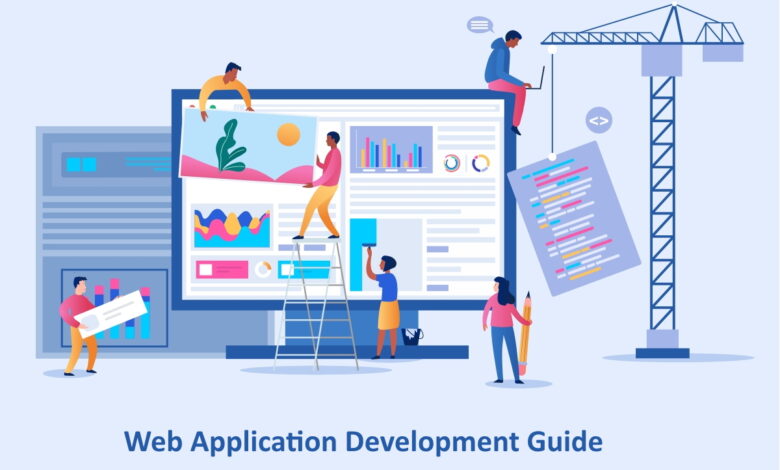The Ultimate Guide to Web Application Development

What is the definition of a Web Application?
A web application is an application program that is often hosted on a distant server and may be accessed by users using software known as a web browser.
It is a type of computer application that typically runs in conjunction with a web browser and uses a variety of web technologies to carry out various functions on the internet. A web application can be created for a variety of purposes and can be utilized by anyone, such as a person or an entire business.
Some web applications require a specific type of web browser to access them. We can’t use conventional web browsers to access these types of web applications. Most web apps available on the internet, however, may be accessed using a basic web browser.
Mobile Applications vs. Web Applications
Native mobile apps are designed specifically for certain device characteristics and run on smartphones and tablets. Web apps are accessed through web browsers and adapt to the device of the user. Web apps, unlike native mobile apps, aren’t tied to any particular operating system or device, thus they don’t need to be downloaded or installed.
The nicest thing about web apps is that they are extremely responsive to the devices they are used on, to the point where they can sometimes serve as a mobile app.
The difference between these two types of apps is that online apps require an active Internet connection to function but mobile apps can frequently function even when not connected to the Internet.
Mobile apps are often faster and more efficient than online apps; nevertheless, to maintain optimal operation, users must download updates on a frequent basis, whereas web apps update automatically.
Development of both Mobile App & Web App requires hiring dedicated web developers.
The Advantages of Web Application Development
Here are some of the benefits of Web Application Development:
- Web apps are created using computer languages that are well-known among IT experts, such as HTML and CSS.
- Unlike native apps, a single web app can be used on multiple devices. It’s made to work with any operating system. It can work with a wide range of operating systems.
- These apps can be accessed by typing a simple URL into the device’s web browser.
- They don’t need to be downloaded and installed from an app store like Google Play or Apple’s App Store. This saves money because having a direct link through a web app is free.
- They may also access the internet. This means they don’t require the same level of maintenance as traditional apps. In this manner, the website to which the application is linked will be updated.
- The most significant benefit you can obtain from it is its low cost. The least expensive type of app creation is web app development. It includes creating a link (or several links) between the app and a URL. The cost of developing native software or an interpreted app is more, but the chances of success are far higher.
- A web app, on the other hand, takes less time to develop. As a result, it’s less expensive.
Step-by-Step Procedure for Web Application Development
Successful web app development involves meticulous planning, strong architecture, and up-to-date technologies and frameworks. But, more crucially, it necessitates taking intentional actions to create a future-proof online application.
We’ve included a tried-and-true step-by-step procedure as explained below:
Choose the Type of Web App
There are more than seven different sorts of web applications that you can create for your company.
- Web Applications That Are Static
Static web apps are the most basic sort of web application because they do not interact with users directly and are difficult to update or modify. They are created with HTML, CSS, and JQuery. It serves the same information to every visitor as a collection of static web pages. You can, however, add basic animated components, films, GIFs, and interactive banners to make it look more appealing.
If you only want to convey information about your company and do not want to accept customer input, you should consider creating a static web application. You can even look forward to hire dedicated web developers for assistance.
- Web Applications that are Dynamic
As the name implies, dynamic web apps are both flexible and interactive, allowing users to input data such as posting a remark, filling out a contact us form, creating a user profile, searching for specific information, and so on.
They are, nevertheless, more complicated in structure than static web apps. The good news is that developing a dynamic web application does not necessitate any form of server connection, making it simple to integrate functionality.
- Web Applications for eCommerce
If you want to sell anything online, you’ll need to create a web application that handles payments and orders.
eCommerce web applications differ from dynamic web apps in that they can handle additional functionality such as keeping a product database, offering a shopping cart, managing orders, tracking orders in real-time, accepting online payments, and so on. eCommerce website development services too can be availed for better understanding.
- System of Content Management
A Content Management System (CMS) enables the creation, editing, and management of website content. WordPress, for example, is a popular CMS that includes the tools required for website administrators to customize their online applications.
A CMS web application enables a firm to maintain track of all assets and is straightforward to construct, even for non-technical people. There are numerous web application development frameworks with pre-built tools available on the market that you may use to create your own CMS web application.
- Single-Page Apps
Single-Page Apps, or SPAs, are browser-based applications that do not require refreshing in order to show content. SPAs, in a nutshell, dynamically rebuild the current web page with fresh data, removing the need to reload your browser many times to display new information.
SPA is a significantly more complex sort of web application because it is constructed with both frontend and backend technology. On the plus side, SPAs provide a considerably superior experience to end-users.
- Applications with Multiple Pages
To see the changes on a page, the Multi-Page Applications must be reloaded. MPAs, like other types of protected areas, have a complex architecture. For example, when a user requests data, the page is reloaded in the browser with the updated information. In other words, MPAs have several pages with static content and links to internal pages.
- Progressive Web Applications
PWAs are the most recent and popular innovation in the web application industry. A PWA is more than a simple web application. It combines the greatest elements of a conventional website and a native mobile app to provide the best user experience of any form of online application.
Choose a Technology for Your Web App
Once you’ve decided on the type of web application you want to create for your company, you can proceed to the following stage. At this point, you must pick which technology will be best for developing your web application.
Cost of Web Application Development
The only thing left to discuss now that you’ve grasped the complete strategy to develop a great web application is the cost of web application development. The cost of developing a web application is unquestionably an important factor to consider. Estimating the cost of web app development, on the other hand, is a time-consuming process.
In other words, the cost of web application development is determined by a variety of factors. However, it is mostly determined by the following two factors:
- The Project’s Difficulty
The project’s complexity is dictated by the individual project needs. For example, if your web app only includes a few basic functionalities like login and navigation, the cost of developing a web application can be rather minimal. If, on the other hand, your web app requires the construction of multiple complicated features, the cost to design a web application will almost certainly increase because you’ll need to engage senior-level experts.
- Cost to the Developer
The cost of the developers you hire has a significant impact on the final cost of your web app project. To put it another way, the expenses of developers vary greatly depending on their knowledge, experience, and skillsets.
Conclusion
Web application development has become increasingly important for enterprises, particularly in the aftermath of the COVID-19 Pandemic. In fact, in today’s digital environment, reaching a large number of clients without the help of a well-developed web application is nearly impossible.
As a result, web app development has become a more common way that will continue to grow in popularity for many years to come. Web apps are preferred by both organizations and individuals because of their vast functionality, excellent engagement, and outstanding performance.






